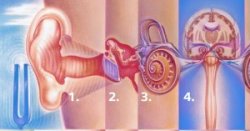HOW WE HEAR

1. Outer Ear: The outer ear includes the pinna and ear canal. The pinna collects sound and delivers it to the ear canal. If you cup your hand around your ear, you will notice that you hear more. This exercise illustrates the effect the pinna can have on your hearing. The ear canal should be free of large amounts of wax or any foreign body for you to hear your best.
2. Middle Ear: The middle ear consists of the eardrum and three tiny bones. The eardrum vibrates in response to sound and transfers the vibration to the inner ear by use of the bones. The middle ear is normally a dry-filled space, but sometimes fluid builds up. This makes it more difficult for the sound to get to the inner ear.
3. Inner Ear: The inner ear consists of the cochlea and the auditory nerve. The cochlea is a fluid-filled space. When the sound vibration enters the cochlea, a traveling wave occurs. The wave moves the tiny hair cells within the cochlea, which sends an electrical message to the brain via the auditory nerve. Many things like noise exposure, certain drugs and aging can cause damage to the hair cells. This leads to hearing loss.
(Illustration Courtesy: Better Hearing Institute)